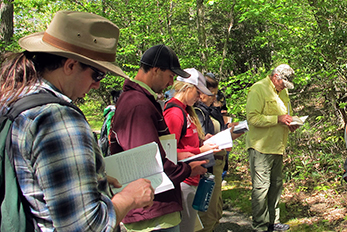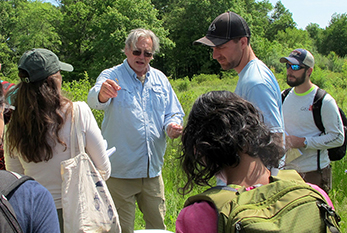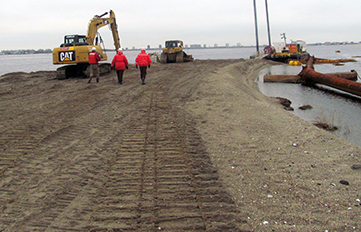Main Content
Discover how to plan and design a functional wetland, including assessing the distribution of hydrology on your site and creating usable hydrographs.
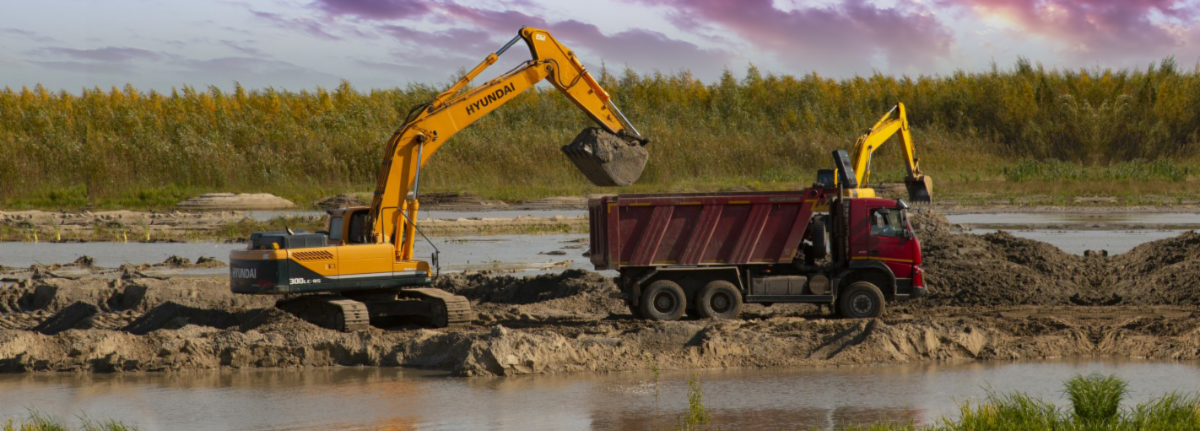
Course Status: Registration Closed!
Online registration has closed. Please join our email list to be notified when the next offering is scheduled.
Jump to: Overview | Instructor | Reviews | CE Credits | Contact Us | Related Courses | Join Email List
Course Details
Course Name: Wetland Construction: Principles, Planning, and Design
Course Code: EH0604WA26
Date of Most Recent Offering: October 23, 24, 27, and 28, 2025
Course Overview
As state and federal wetland mitigation standards evolve away from an acre-for-acre approach to a focus on replacing wetland functions, your understanding of the wetland’s “wet part” has never been more critical.
This online class serves as an introduction to the fundamentals of functional design and provides both the means to rapidly assess the distribution of hydrology on your site and create usable hydrographs for presentation of your wetland design.
Building on the student’s understanding of wetland functions, this course will also guide you through the many factors required to plan and design a functional wetland. Through online lessons, you will learn real-world applications with an emphasis on two key components that drive success: DDT (depth, duration, and timing) of site hydrology and the landscape position.
Featured Topics
- Hydrogeomorphology: The importance of landscape position and where water is coming from
- Water Budget Calculation: Water inputs/outputs and TR-55 runoff curves
- The Thornthwaite Method: One method for calculating evapotranspiration
- Estimating Stream Flow and Producing Basic Hydrographs: Create usable hydrographs for presentation of your wetland design
Learn How to Develop a Successful Wetland Construction Plan
The course concentrates on the five basic steps in the process of developing a successful wetland construction plan.
1. Planning Your Project
Before developing a wetland construction plan, you must understand the purpose of the wetland and the ultimate goals of the project. Your overall wetland plan must account for location, size, physiognomy, basic hydrologic regime, and current/future land use. The proposed primary function(s) must be specific, measurable, and achievable. The wetland is built by constructing structural elements that support the primary function(s).
2. Selecting Your Construction Model
You must select appropriate models for construction. The hydrogeomorphic model analyzes suitable water supply and landscape position, while the wetland construction model covers basic methods of wetland construction suited to the nature of the water supply.
3. Preparing Your Water Budget and Hydrograph
Water inputs and outputs must be used to prepare water budgets and hydrographs. Successful hydrograph preparation is reliant on data collection and interpretation. Using the results of the modeling facilitates the preparation of the hydrograph.
4. Determining Proper Vegetation
Vegetation adaptation, selection, and planting are keys to any successful wetland construction plan. You must verify the adaptive modes of plants suitable for your hydrologic regime, and accurately match these plants with your project. You must locate plants that represent native species assemblages and select proper planting methods.
5. Manipulating Soil
Sub-grade soil percolation must be suitable for the hydrogeomorphic model you develop. Substrate soils must prove suitable to support selected vegetation selections both in texture and nutrient composition.
Learner Objectives
At the conclusion of the course, students will be able to display their proficiency in planning and designing a functional wetland, using the components of successful applications demonstrated during class presentations.
Why Take Our Wetland Construction Design Course?
This class will introduce you to the fundamentals of functional design and provide you with the means to rapidly assess the distribution of hydrology on your site and create usable hydrographs for presentation of your wetland design.
Rutgers instructors pioneered this functional hydrologic approach to wetland construction and have been teaching it since 1988. We are still one of only two schools in the nation that teach this approach.
Who Should Attend?
This class is intended for individuals seeking to learn how to develop successful wetland construction plans, as well as any environmental professional in the process of obtaining wetland permits. Past participants have included:
- Biologists
- Botanists
- Computer Assisted Design (CAD) Professionals
- Design / Civil Engineers
- Ecologists
- Environmental Consultants
- Environmental Specialists
- Environmental Scientists
- Field Biologists
- Hydrogeologists
- Landscape Architects/Designers
- Planners
- Project Managers
- Restoration Technicians
- Water Resources Specialists
- Watershed Specialists
- Wetland Scientists/Specialists
 Required Textbook
Required Textbook
A bound-copy of the required course text, Wetland Mitigation: Planning Hydrology, Vegetation and Soils for Constructed Wetlands by Gary J. Pierce, is included in your registration fee.
Do you work on wetland construction projects or want to learn more about this topic? Check out these two articles, which contain helpful tips and information to help make your next project a success.
Meet Your Instructor
Roy Messaros, Ph.D., PE, PWS, CFM

Roy Messaros is a Senior Research Project Manager working in the Rutgers Cooperative Extension Water Resources Program. He has a doctorate in Civil/Coastal Engineering from Stevens Institute of Technology and an M.A. and B.S. in Biological Sciences from William Paterson University.
Dr. Messaros’ professional experience and expertise includes hydraulic and hydrologic modeling, design, and construction for flood risk management, FEMA inundation mapping and certification, coastal storm surge protection, and wetland restoration/mitigation projects. Beneficial reuse of dredge material for tidal marsh restoration efforts has also been part of his wetland restoration experience.
He holds a Professional Engineering (PE) license in New Jersey. Messaros has 20 years of experience and a great passion for water resources, hydrology, and hydraulic analysis, wetlands for water quality improvement, limnology, and all things relating to ecosystem resilience and coastal engineering. His unique background and expertise across a variety of disciplines and services, both in engineering and science, allows him to bring a truly comprehensive approach to the Water Resources Program.
Messaros has extensive teaching experience serving as an adjunct professor at New York University Tandon School of Engineering and Stevens Institute of Technology, instructing both undergraduate and graduate level courses. He is particularly skilled at conveying complex ideas and concepts related to hydrology, watershed modeling, watershed resources engineering, and wetland design. His applied experience at the USACE and teaching provides a useful combination of knowledge of complex, technical concepts and the ability to share it with others through guidance and mentorship.
Student Reviews
“Real-world practical knowledge [covering] every aspect of building wetlands was provided. I learned a lot about nuances of water budgets, and I will use the hydrograph tool in the future when planning wetland design.”
– Kristen Andersen
Technical Specialist, Wetland Restoration“Instructors provided a holistic approach to the fundamentals of wetland design that made the content digestible for students without a background in engineering or hydrology. I really enjoyed how the instructors provided useful tools such as the hydrographs and the repetition of core concepts, such as functional design and DDT [depth, duration, and timing].”
– Niel Gapal, Applied Technology & Science
Project Biologist“[Learning] the steps involved, things to watch for when assessing inputs and outputs, being able to integrate these into a hydrograph, [and] being better able to assess them in the field has made me much more confident entering this year of work. This has given me a solid background that I can base my [wetland construction] assessment on.”
– Marisa Roefs, Maitland Conservation
Stewardship Projects LeadContinuing Education Credits
The most recent offering of Wetland Construction: Principles, Planning, and Design was approved for 2.4 Rutgers CEUs (24 contact hours), as well as the following credits from professional organizations. We will reapply for similar credits the next time the course runs, but we cannot guarantee credit approval for future offerings.
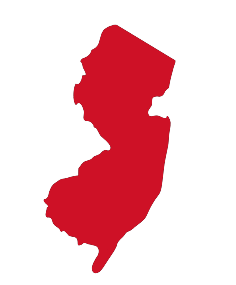 New Jersey
New Jersey
NJ Certified Public Works Managers (CPWM): 15 Technical, 3 Management, 3 Government Contact Hours
NJ Drinking Water and Wastewater Operators: 22.5 TCHs (Approval #01-091901-30)
NJ Health Officers and Registered Environmental Health Specialists (HO/REHS): Rutgers University, NJAES, Office of Continuing Professional Education has been approved by the New Jersey Department of Health as a provider of NJ Public Health Continuing Education Contact Hours (CEs). Participants who complete this education program will be awarded 20.0 NJ Public Health Continuing Education Contact Hours (CEs).
NJ Professional Engineers: 18 Continuing Professional Competency (CPC) credits
 New York
New York
NY Landscape Architects: 17.75 hr CL; 3.5 hr EA
NY Professional Engineers/Land Surveyors: 22 PDHs
 National
National
Society for Ecological Restoration (SER) Certified Ecological Restoration Practitioner (CERP) Program: 10 CECs
Society of Wetland Scientists Professional Certification Program (SWSPCP): 0.8 equivalent semester hours
Program Questions? We’re Here to Help!
If you have any questions about Wetland Construction: Principles, Planning, and Design, please don’t hesitate to reach out to us.

Program Coordinator: Suzanne Hills
848-932-7234
suzanne.hills@rutgers.edu

Administrative Assistant: Amy Smith
848-932-7764
amy.smith70@rutgers.edu
For registration assistance, please contact our Registration Department at 848-932-9271, option 2 or email registration@njaes.rutgers.edu.
